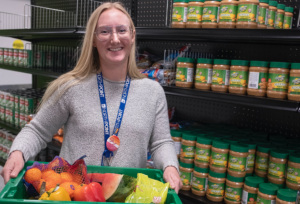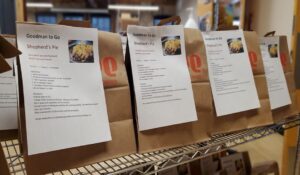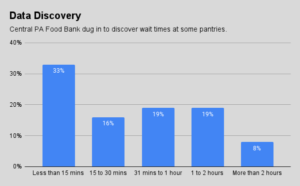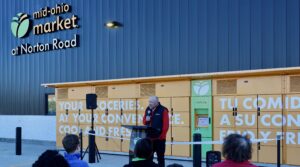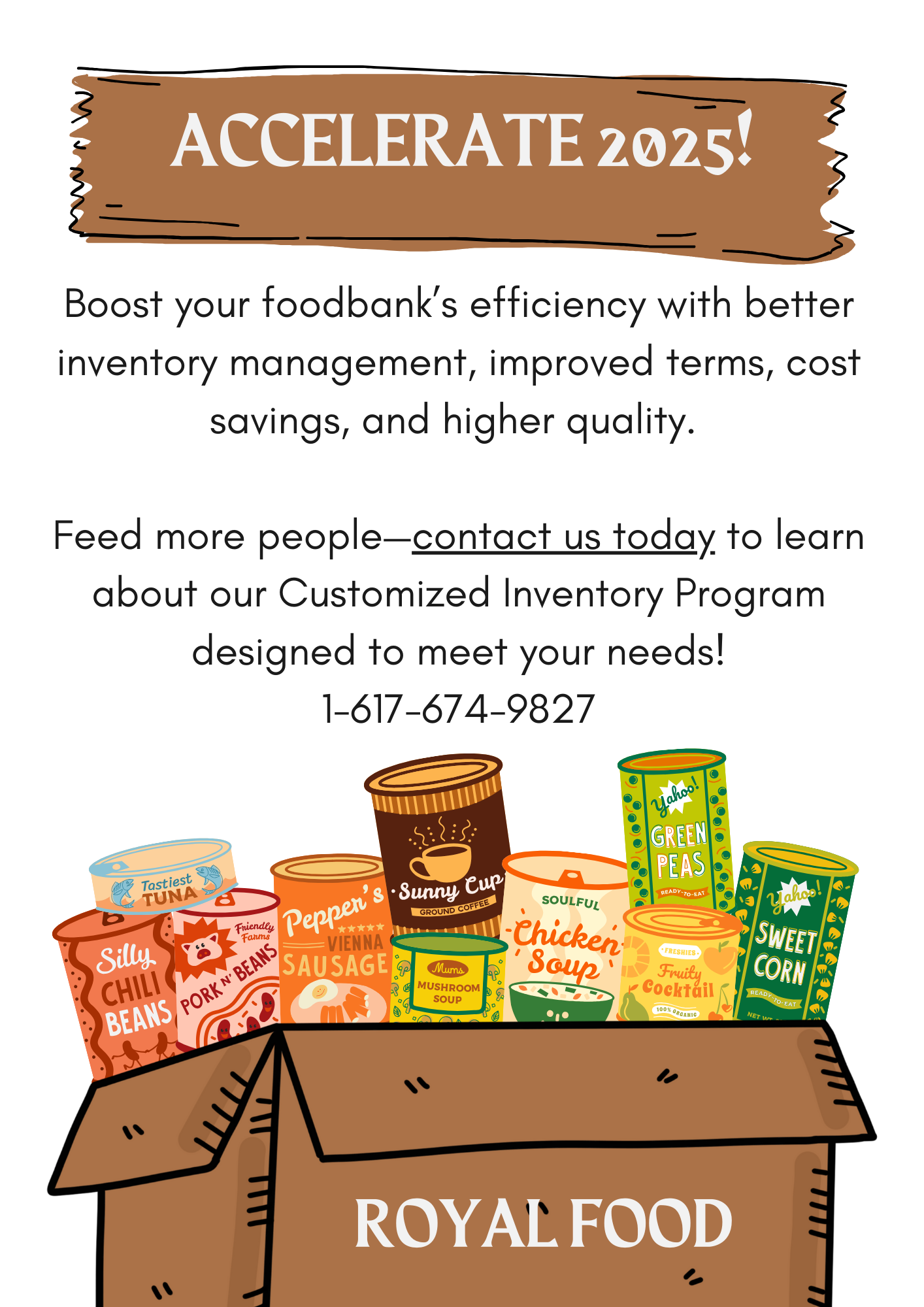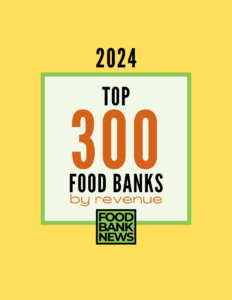We have operated a small food pantry in our rural upstate New York community for the past 12 years. Like many of you, we have a volunteer staff and a small budget provided by government grants and community donations. Very close to 100% of our budget goes directly toward the food we are able to provide to approximately 35 families per week.
 Before Covid-19, our clients waited in a room that is half of the full-length trailer in which we operate the pantry, and we would personally escort each client through the other half of the trailer to help them select food items from our stocked shelves. Between waiting and being served, each client was there approximately an hour.
Before Covid-19, our clients waited in a room that is half of the full-length trailer in which we operate the pantry, and we would personally escort each client through the other half of the trailer to help them select food items from our stocked shelves. Between waiting and being served, each client was there approximately an hour.
When Covid-19 hit, those tight quarters were no longer viable, so we created a paper form from which clients could select their items. Our staff collects the food for the clients, while they wait outside. We update the paper form each of the two days per week we are open because our stock varies from week to week. Approximate wait time for each client is still about an hour.
We wanted to reduce the wait time for our clients and have a more flexible system for our ever-changing inventory, so we investigated existing options that would enable our clients to order online. We were initially frustrated with what we found, because most online ordering tools are designed around paying for products, including how much each item costs and accepting a credit card to pay for it. Our pantry provides food free of charge, imposing only a maximum number of items per client, based on family size.
In researching what other food pantries used for online ordering, we found most were large food pantries that had contracted to have custom software built for this purpose. We didn’t have the budget for this, nor the skilled staff to maintain it on an ongoing basis.
We investigated all of the popular website building and online merchant tools, including Squarespace, Shopify, Subsplash and IM Creator. Ecwid* turned out to be the only tool that met all of our needs and addressed our constraints and requirements, which were:
- Having a checkout option that does not require payment or providing a credit card. Ecwid has a “pay at pickup” option that allows us to customize the text so we can clarify that clients don’t actually have to pay when they pick up.
- Is inexpensive: We want most of our budget used for buying food. Ecwid is one of the least expensive tools we found ($15/month or $12.50/month paid annually). They even provide six months free for nonprofits! (They also have a completely free version, which is useful for getting started or for exploring whether it is right for you.)
- Can be managed and maintained with little technical knowledge: Most of our staff has no software development experience, so customizing the site via javascript, HTML, CSS, or complex templates was out of the question. Further, Ecwid is focused solely on providing online ordering, so you don’t have to wade through templates or additional features aimed at fostering an online presence like creating a blog, integrating with Instagram, etc.
- Is mature, widely used, and stable: Although not a household name, Ecwid is often used as an e-commerce plugin with other website building tools. It has two billion active users, so we don’t have to worry about it going down or having stability problems.
- Has both website and mobile support: Ecwid can be used and managed from computers and mobile devices (iOS and android).
Having an online option that our clients can use to order food ahead of time has worked out well for our food pantry. For these orders, we can collect the food items ahead of time and have them ready when the client arrives. For the clients that take advantage of this, their wait time is reduced from an hour to usually about 5 minutes. We’ve had new clients tell us that they previously couldn’t take advantage of our pantry because of the long wait times combined with other responsibilities, such as caring for children or older parents.
After providing online ordering for about three months, approximately one-third of our clients were using it. We initially worried that many of our clients wouldn’t have access to a device or be able to navigate the online process. But the clients who use it tell us that it is easy to use, and they often help each other out. One of our regular clients submits the online orders for himself and a couple other clients (who don’t have a device), and they all carpool together to pick up the orders.
Even after we resume the inside operation of our pantry, we plan to continue offering online ordering because of the advantages it provides. It is enabling us to provide food to more families more efficiently, which, after all, is why we do what we do. — Bruce and Mary Lou Potter
Bruce and Mary Lou Potter, pictured above, operate the Bread of Life Food Pantry in Lake Katrine, NY.
* Author’s note: This article is not an advertisement for Ecwid, and we are not compensated by the company in any way. We are sharing this information because we think there may be other small food pantries in our same situation and hope this might be helpful.
More details on how we use Ecwid at our food pantry:
-
-
-
- By default, the URL of your Ecwid site will be https://<yourstore>.company.site/. We chose to get our own domain and connect it to our Ecwid site so it could end in .org. There are several inexpensive domain name providers. We used namecheap.com ($10/year). The domain name and site address section of the Ecwid control panel lets you specify your new domain.
- We did not add any payment methods to Ecwid so pay at pickup is the only choice presented to the user. Further, we customized the text of the pay-at-pickup method to read “No payment required.”
- Ecwid requires us to enter a price for each product or food item we add to our store. We could just set all of them to 0, but we chose to repurpose what the price meant: Our food pantry sets a maximum number of food items each client is allowed per visit, depending on family size. So we set the price of most food items to 1 (and an occasional large/bulk item to 2), so the total “price” in their cart is the number of items they have chosen. (Ecwid has an option in which the prices can be displayed without cents, so they look more like a count.)
- With one click we can open or close the online store. We only open the store on the morning of the days we are open, after we have updated the product inventory available that day.
- The product enable/disable feature is useful so we don’t have to delete an item when it is out of stock, and we can easily re-enable it later when we get more of that food item.
- Client orders can be printed so all of the staff doesn’t need to have access to the store control panel on their phones, and so clients can be given a record of what they ordered.
- The mobile control panel (phone and tablet, iOS and android) is easy to use and has all necessary features, so everything we need to do at the pantry (see orders, change the processing status of orders, etc.) can be done on our phones. This way we don’t need to store any expensive technology at the pantry.
- The Ecwid control panel lets you customize all of the usual text (welcome page, mission statement, checkout instructions, etc.). But under Settings -> Edit Store Labels it also gives you a low-level way to customize literally any text in the entire store interface. We’ve used this feature to customize some text to make it more specific to food pantries. You search for the text you want to change, find the label ID, and then set the new text you want for that ID.
- Ecwid’s ability to present in multiple languages is part of a subscription level that costs more than we can afford. But we found that if clients set their browser language to only Spanish, then Google translate will offer to translate the store pages (and it is a close translation). So we have the following line on our front page which points them to instructions (in Spanish) of how to set the language of their browser: ¿Prefieres el español? Cambia el idioma de tu navegador.
- While Ecwid has a free version, the features that caused us to move up to the Venture plan ($15/month or $12.50/month paid annually) were:
- Up to 100 products in the store (rather than a maximum of ten)
- The ability to manage the store with the mobile app
- The ability to connect our own domain name
- Online chat support (instead of only email)
-
-
If you would like to set up online ordering for your nonprofit food pantry using Ecwid, but need some advice, we would be happy to dialog with you. Contact us at bol-online@kingsfire.org. — Bruce and Mary Lou Potter
Like what you’re reading?
Support Food Bank News
